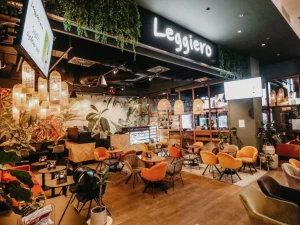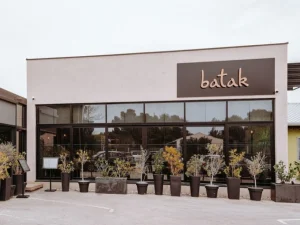If you thought that running a restaurant revolves only around great food or a fabulous location – think again. It’s about everything that happens behind the scenes – every checklist, every shift schedule, every delivery, and every tiny moment that influences a guest’s experience.
You’ve probably experienced it – when things run like clockwork, your team is energized, guests are happy, and the vibe is just right. But when one piece falls out of place? Chaos. Long wait times, grumpy staff, and food that doesn’t live up to the standard. And this happens everywhere – from small and cozy cafes, busy restaurant chains to high-end dining spots.
This guide is here to change that.
We’ll go through everything that keeps restaurant operations running smoothly – from managing people and processes to using smart tools that take the pressure off your team.
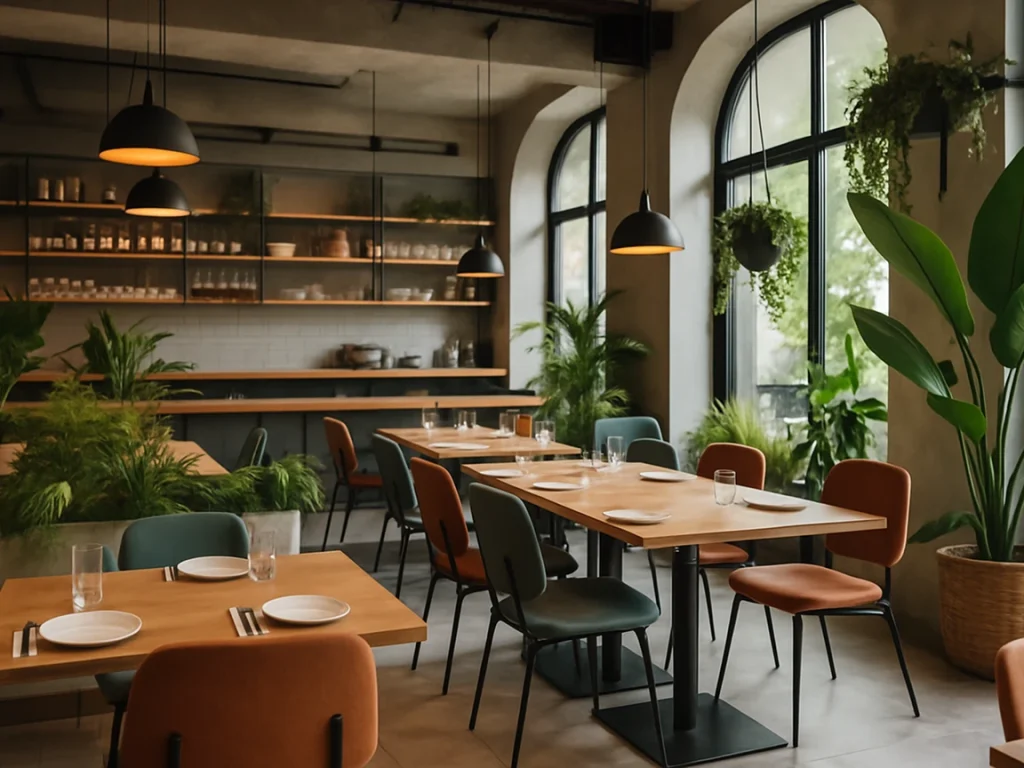
What Are Restaurant Operations?
Let’s break it down: restaurant operations are everything that keeps your business running on a daily basis. It’s not just what the guests see – it’s the whole engine behind closed doors.
At its core, restaurant operations include:
Front of House (FOH): Those are servers, hosts, bartenders and everything in between – the people and processes that shape the guest experience from the moment someone walks in.
Back of House (BOH): This refers to the kitchen staff, dishwashers, prep stations, and all the systems that keep the food coming out and standards high.
Compliance and safety: Health codes, cleanliness, allergen protocols and similar – everything that is critical for building trust and staying legally protected.
Staffing and scheduling: Hiring, training, shift planning, and retention. Remember: good chemistry and clear roles keep things from falling apart under pressure.
Inventory and supply chain: Making sure you’ve got the right ingredients, at the right time, without overstocking or running out in the middle of the rush.

In short, operations are your invisible superpower. When they work, your restaurant feels effortless. When they don’t? Everything seems much more difficult.
Common problems in unmanaged operations
When you don’t have a clear structure and tools, things can go wrong very fast. Here are some of the things that happen most frequently in these situations:
Missed tasks: If you don’t have structure, it’s easy for very important tasks to get overseen. Maybe the trash doesn’t get taken out before service, which can create a hygiene issue. Or the restrooms go unchecked during a busy lunch rush, which can have a bad effect on your brand. Daily prep might get skipped or rushed, which affects the kitchen’s flow. These “small” oversights can really add up, and guests always notice when something feels off.
Lack of accountability: When responsibilities aren’t clearly defined or tracked, things get easily confused. A dishwasher assumes that a line cook will close the walk-in fridge. A server thinks the closing checklist includes emptying the soda machine, when it doesn’t. These gray areas lead to expensive mistakes, health code violations, or even food safety risks. And when something goes wrong, it’s inevitable that you’ll be faced with a lot of finger-pointing.
Inconsistent guest experience: Different staff, different shifts, different standards – without SOPs, everything is possible. One location might serve a perfectly plated dish ang guests get greeted with warm hospitality, while another forgets sides, skips wiping the tables, and lets the music play too loud. That inconsistency confuses guests and destroys brand trust. It doesn’t matter if you’re a single-location spot or a growing chain, every customer should have the same high-quality experience, every time.
Stress and burnout: When there’s no system, everything feels urgent – and this fact burns people out. It leads to the team spending half the shift figuring out what they need to do, and the other half rushing to make it on time. Managers spend more time chasing missed tasks than coaching and improving the service. And this is already a recipe for disaster since it ultimately leads to unhappy employees leaving and high turnovers, which has a huge impact on your time and money.
So how to avoid these scenarios and where to start? Here are some tips.

Key Pillars of Effective Restaurant Operations
Behind every well-run restaurant are a few key building blocks that keep the chaos under control. Let’s break down the six pillars that hold everything up – and how to get the most out of each.
People management
Here’s a fact that often gets forgotten: your people are your power.
From the waiter to the head-chef, your team is the one creating the most of the guest experience. That’s why investing in hiring, training, and retention is one of the most important processes.
Hiring: Look beyond the resume. Attitude, willingness to learn, and work ethic often matter more than experience.
Training: Clear, consistent onboarding sets the tone. This means investing in videos, shadowing, and SOPs that are simple and easy to follow.
Retention: Celebrate wins, offer feedback often, and create a place where people want to work.
🚀 Pro tip! Use digital tools like 7tools for smart scheduling and real-time performance feedback to avoid burnout and boost morale.
Standard Operating Procedures (SOPs)
Standard operating procedures (SOPs) are here mainly to ensure consistency which everyone needs, from big restaurant chains to small cafes. They ensure that a guest dining on a Tuesday at Location A gets the same quality experience as one visiting Location B on a Friday.
To be effective, SOPs should be simple, visual, and easy to access – always choose bullet points over explaining everything in long paragraphs. And when it comes to training, don’t just hand out a manual. Bring SOPs to life with short videos, live demos, or hands-on walkthroughs that will actually make it easier to remember for your team.
🚀 Pro tip! Digitize your SOPs! Paper gets lost, stained, or ignored. Digital checklists are easy to update, track, and actually use – especially on mobile.
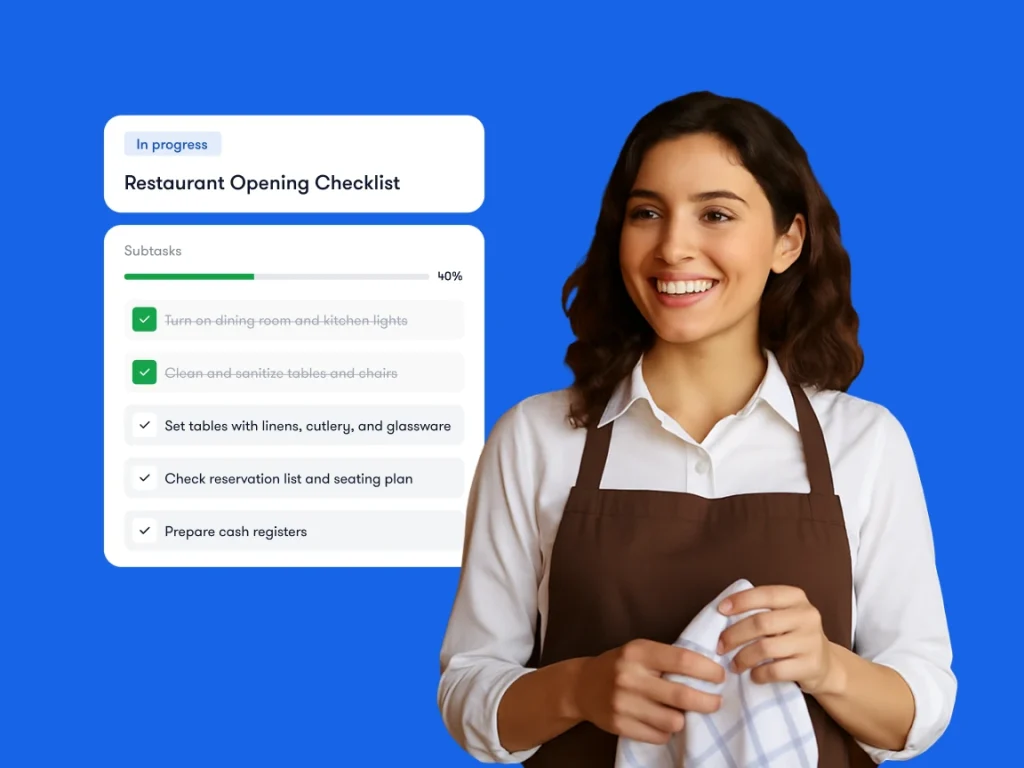
Task and audit management
Restaurants live and die by the little things done right – every single day. A restaurant is held together through daily tasks done right, which keeps everything running smoothly.
Tasks like opening routines, cleaning schedules, restocking stations, and end-of-day reporting are the crucial part of daily operations. When these small (but very important) steps are followed consistently, they create a reliable flow that the whole team can count on. Guests might not see the checklist, but they absolutely feel the difference when a restaurant is clean, organized, and running efficiently.
Audits are equally important. Regular inspections, whether scheduled or surprise, help ensure that standards don’t slowly slip over time. A good audit is more than catching problems; it reinforces the expectations you’ve set for your team and highlights where additional training or support might be needed. Without audits, even well-established routines can slip, leading to inconsistencies that guests (and eventually, regulators) will notice.
🚀 Pro tip! Use tools for task management. Checklists in an app like Bitreport mean nothing’s forgotten. Area managers can check status in real time and follow up fast.
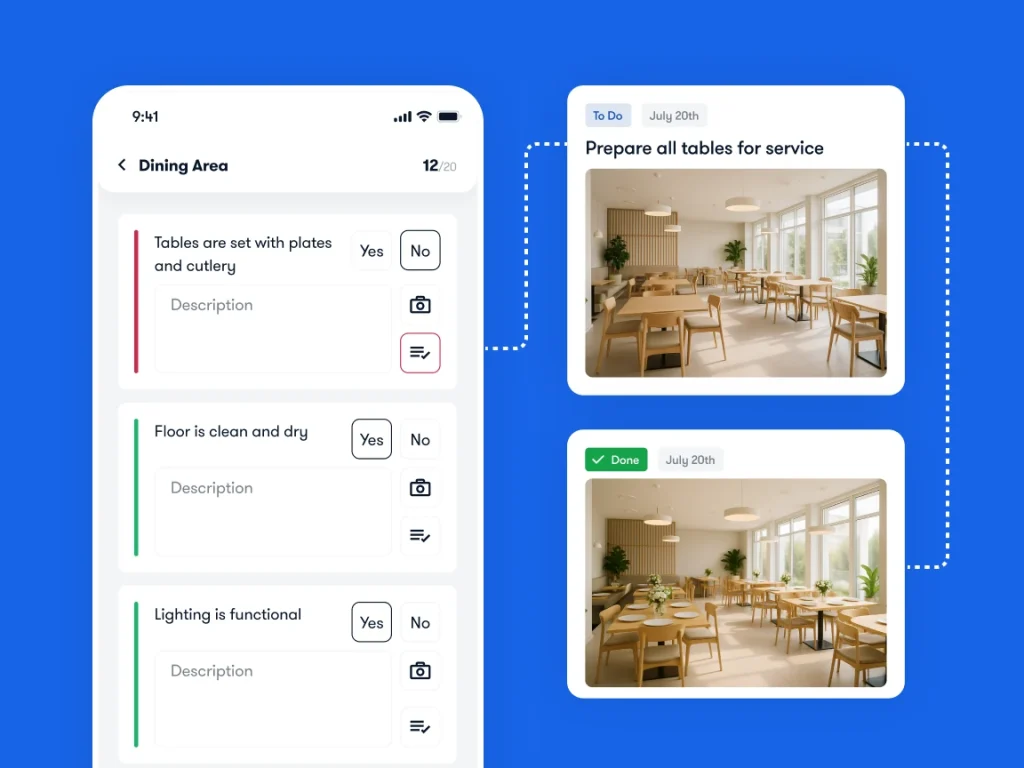
Inventory and supply chain
Inventory drama? We’ve all been there – running out of key ingredients mid-service, discovering spoiled stock in the back, or dealing with unexpected price increases. But with the right systems in place, you can shift from reacting to predicting – and run your kitchen with a lot less stress.
Best practices start with the basics: Set clear par levels for each item (the minimum amount you need on hand) so you know exactly when you need to reorder. Rotate your stock religiously using the FIFO method (First In, First Out) to minimize waste and ensure your stock is always fresh
Reducing waste is another big win. Track the usage trends – what sells fast, what sits too long – and you can easily fine-tune your ordering and stop over-buying “just in case.” Less spoilage means better margins and a happier kitchen crew that’s not constantly tossing expired goods.
Vendor relationships are the secret sauce for smooth operations. Reliable suppliers mean fewer shortages, better pricing, and a lot less day-to-day drama. Keep communication tight: confirm delivery schedules, double-check order accuracy, and stay informed about any price or product changes. A strong partnership with your vendors can save you time, money, and a ton of headaches.
🚀 Pro tip! If you use software like MarketMan it’s much easier – real-time data helps you catch trends, prevent stockouts, and avoid food waste. With Excel it’s highly likely that there will be a lot of guesswork involved. And that is something you’d definitely want to avoid.
Guest experience & quality control
You can have the best kitchen in the world, but if guests don’t feel taken care of, they won’t come back. Cleanliness, speed, and consistency are the pillars of guest happiness, and they need to be flawless every day. Outdated comment cards won’t cut it anymore; modern feedback tools like digital surveys and QR-code check-ins let you collect guest opinions at scale and act on them quickly.
Surprise audits also play a big role, helping you catch small issues before they turn into bigger problems, especially when managing multiple locations. Great food brings people in once, but an amazing experience brings them back.
🚀 Pro tip! Tools like Tattle help you spot issues fast, assign fixes immediately, and keep every guest experience consistent and memorable.

Technology and tools
Research shows that 77% of restaurants increase their efficiency with implementation of new technology. When you choose the right tools, you’re giving your people better ways to do their jobs and you’re freeing up time for what really matters: delivering an amazing guest experience.
POS systems are the backbone of modern restaurant operations. A good POS makes sure orders are taken accurately, sent instantly to the kitchen, and logged for easy reporting. It speeds up turnaround times, reduces mistakes, and gives you real-time data on sales, trends, and staff performance.
Kitchen display systems and reservation platforms add another layer of efficiency. Kitchen displays reduce problems with food orders, make it easier to prioritize orders, and keep the whole line organized during busy periods. Reservation platforms help you seat guests smoothly and cut down on long waits and unhappy walk-ins. Together, they reduce confusion, improve communication, and keep the energy on the floor positive instead of panicked.
Operations software like Bitreport ties it all together. Instead of juggling paper checklists, sticky notes, and endless spreadsheets, platforms like Bitreport let you manage tasks, checklists, audits, and compliance in one central place. Managers can instantly see what’s done, what’s overdue, and where support is needed, which saves hours every week and helps teams stay on track without micromanagement.
🚀 Pro tip! Make sure your tech stack talks to each other. Meaning: your tools should be connected and share information automatically. For example: your POS system sends sales data to your inventory tool, or your reservation system updates your table management software without you having to do anything manually. The goal? Fewer manual steps, more time for guests.
Together, these pillars create a foundation that’s built to last—and scale. Get them working in sync, and you’ll have a restaurant that runs as smoothly as it looks.
Benefits of Streamlined Restaurant Operations
So why go through all the effort to fine-tune your operations? Because when things run smoothly behind the scenes, everything gets better: front of house, back of house, and most importantly – your guests are happier.
Let’s look at the biggest payoffs:
Higher efficiency, fewer errors
Higher efficiency and fewer errors start with a team that knows exactly what to do, and has the right tools to do it. Studies show that clear task management and digital tools can boost operational efficiency by up to 30%, reducing costly mistakes and service delays. When everyone’s on the same page, tasks get done without the guessing games or missed steps that slow things down.
The result? Faster table turns, shorter wait times, and better service all around. You’ll also see fewer order mistakes, less food waste, and far fewer “oops” moments that hurt your bottom line.
Stronger brand consistency across locations
If you’re running multiple locations, consistency is everything. Guests should enjoy the same great experience whether they visit your flagship restaurant or a smaller branch across town. That kind of reliability doesn’t happen by accident – it’s built through strong systems. SOPs and standardized checklists give every team a clear playbook to follow, while real-time audits and feedback loops keep quality in check before small issues turn into big problems.
Centralized tools like Bitreport make it easy for HQ to stay connected to what’s happening on the ground, without constant check-ins or micromanaging. Brand trust is built on consistency and streamlined operations are what make that possible.
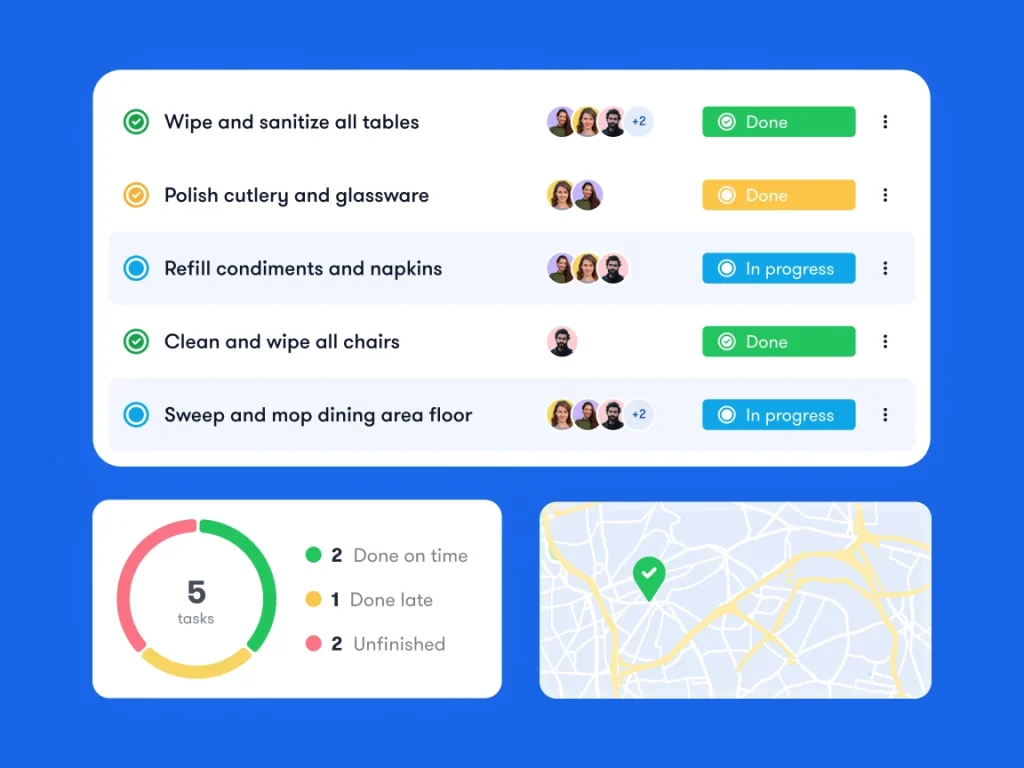
Happier teams and guests
When your operations are messy, your team feels it. And so do your guests. But when everything’s organized and running smoothly, everything changes. Staff feel supported instead of stressed, managers spend less time putting out fires and more time coaching and leading, and guests immediately notice the difference: faster service, cleaner spaces, and more genuine smiles all around.
Happy teams create happy guests. It really is that simple.
More time for innovation and growth
Once your day-to-day operations are under control, you finally get some breathing room, and that’s where the magic happens. With a solid foundation in place, you can experiment with new menu items without overwhelming the kitchen, launch loyalty programs or host events to boost engagement, and even expand to new locations with confidence, knowing your systems are built to scale.
When you’re not constantly putting out fires, you have the freedom to focus on growth, innovation, and creating an even better experience for your guests.
Your Ops Are Your Edge
You can have a great concept, top-tier ingredients, and the perfect playlist, but without solid operations, your restaurant won’t reach its full potential.
Dialed-in operations aren’t just about avoiding chaos. They’re how you:
Deliver consistent, high-quality guest experiences.
Empower your team to succeed and grow.
Unlock the efficiency that leads to real profit and scalability.
And the best part? You don’t have to do it alone.
Tools like Bitreport take the guesswork out of daily ops, making it easier to track tasks, standardize procedures, conduct audits, and keep your entire team on the same page – from a single platform.
If you’re ready to spend less time firefighting and more time focusing on growth, it’s time to streamline your operations.




